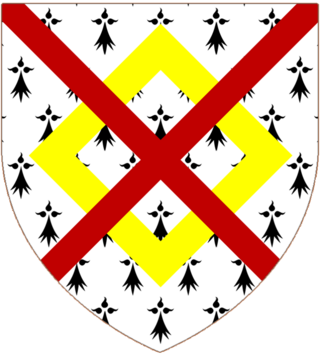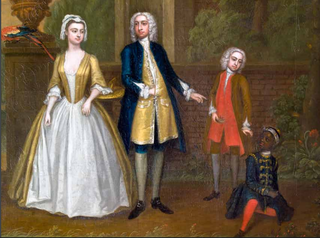
Richard Talbot, 1st Earl of Tyrconnell PC was an Irish politician, courtier and soldier.
The Lord High Steward of Ireland is a hereditary Great Officer of State in the United Kingdom, sometimes known as the Hereditary Great Seneschal. The Earls of Shrewsbury have held the office since the 15th century. Although the Irish Free State, later the Republic of Ireland, became independent in 1922, the title remained the same, rather than reflecting the region of Northern Ireland, which remains within the United Kingdom.
John Butler, 17th Earl of Ormonde, 10th Earl of Ossory (1740–1795) was an Irish peer and Member of Parliament (MP). He became a Protestant in 1764. He was an Irish MP, representing Gowran between 1776 and 1783, and Kilkenny City between 1783 and 1792. In 1791, his right to the peerage was acknowledged in the Irish House of Lords and he became the 17th Earl of Ormond.
Walter Butler (1703–1783), also known as Walter Butler of Kilcash, and Walter Butler of Garryricken, was the de jure16th Earl of Ormond and 9th Earl of Ossory. He did not assume these titles, as he thought them forfeit as a result of the attainder of the 2nd Duke of Ormonde. In the peerage of Ireland, the titles were successfully claimed in 1791 by his son John, the 17th Earl.
Elizabeth Dowdall ; c. 1600 – after 1642) was a member of the Irish gentry, famed for having defended Kilfinny Castle, County Limerick, against the insurgents during the Irish Rebellion of 1641.

John David FitzGerald, Baron FitzGerald, PC, PC (Ire) was an Irish judge and Liberal politician.

Henry Dillon, 8th Viscount Dillon was an Irish soldier and politician. In 1689 he sat in the Patriot Parliament. He fought for the Jacobites during the Wiiliamite War, defending Galway against Ginkel and surrendering it in 1691 after a short siege. He obtained the reversal of his father's attainder in 1696 recovering his father's lands.
Sir William Talbot, 1st Baronet, was an Irish lawyer and politician. He sat as MP for County Kildare in the Parliament of 1613–1615 and was in 1628 one of the negotiators of the Graces. However, he is probably mainly remembered as the father of Richard Talbot, 1st Earl of Tyrconnell.
Richard Southwell was an Irish politician.
Thomas Southwell, 2nd Baron Southwell PC (Ire), FRS, styled The Honourable from 1717 until 1720, was an Irish peer, politician and freemason.

Thomas George Southwell, 1st Viscount Southwell was an Anglo-Irish military officer, peer and politician who served as the governor of Limerick from 1762 to 1780.
Sir Edmond Stanley SL (1760–1843) was an Anglo-Irish lawyer and politician who served as Serjeant-at-Law of the Parliament of Ireland, Recorder of Prince of Wales Island, now Penang, and subsequently Chief Justice of Madras. The elopement of his teenage daughter Mary Anne in 1815 caused a notable scandal. His career was hampered by his enormous debts, as a result of which he was forced to resign his Irish office.

Edward Southwell, 20th Baron de Clifford was a British politician.
The High Sheriff of Kerry was the British Crown's judicial representative in County Kerry, Ireland from the 16th century until 1922, when the office was abolished in the new Free State and replaced by the office of Kerry County Sheriff. The sheriff had judicial, electoral, ceremonial and administrative functions and executed High Court Writs. In 1908, an Order in Council made the Lord-Lieutenant the Sovereign's prime representative in a county and reduced the High Sheriff's precedence. However, the sheriff retained his responsibilities for the preservation of law and order in the county. The usual procedure for appointing the sheriff from 1660 onwards was that three persons were nominated at the beginning of each year from the county and the Lord Lieutenant then appointed his choice as High Sheriff for the remainder of the year. Often the other nominees were appointed as under-sheriffs. Sometimes a sheriff did not fulfil his entire term through death or other event and another sheriff was then appointed for the remainder of the year. The dates given hereunder are the dates of appointment. All addresses are in County Kerry unless stated otherwise.
Sir Stephen Rice (1637–1715) was Chief Baron of the Exchequer in Ireland and a notable supporter of James II.
John Hartstonge or Hartstongue was an English-born prelate of the Church of Ireland who became Bishop of Ossory and then Bishop of Derry.
Sir Henry Hartstonge, 3rd Baronet was an Anglo-Irish politician and landowner who sat in the Irish House of Commons as member for County Limerick. He was a close political associate of his influential brother-in-law Edmund Pery, 1st Viscount Pery. He gave his name to Hartstonge Street, Limerick.
The Dean of Limerick and Ardfert is based in the Cathedral Church of St Mary's in Limerick in the united diocese of Limerick, Killaloe and Ardfert within the Church of Ireland. St Brendan's Cathedral, Ardfert was destroyed by fire in 1641.
John Wandesford, 1st Earl Wandesford was an Anglo-Irish peer.
Sir Henry Talbot of Templeogue, County Dublin, and Mount Talbot, County Roscommon, was a seventeenth-century Irish Catholic landowner, who was elected MP for Newcastle Borough in 1640. His marriage made him a brother-in-law of Richard Talbot, 1st Earl of Tyrconnell.